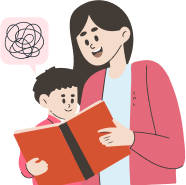If your child struggles to write clear sentences that stick together, it usually comes down to one skill: writing strong paragraphs. For most primary school students, this is where structured writing begins. A well-built paragraph helps children stay on topic, explain their ideas clearly, and improve their results across all subjects, not just English.
Parents often ask, “What does a good paragraph even look like?” This guide answers that in simple terms. We’ll break down what a paragraph is, how it works, the different types, and common mistakes to avoid.
TL;DR:
-
A strong paragraph includes a topic sentence, supporting details, and a concluding sentence- all focused on one clear idea.
-
There are five main types of paragraphs students write in primary school: descriptive, narrative, expository, persuasive, and comparative.
-
Common mistakes include going off-topic, adding too many ideas, or forgetting to conclude, all of which can be fixed with simple techniques.
-
Using transitions, sentence variety, and consistent structure helps improve flow and clarity.
-
FunFox supports students through small group lessons, interactive writing practice, and step-by-step teacher guidance that makes paragraph writing feel achievable.
What Makes a Strong Paragraph?
A strong paragraph is a group of sentences that all focus on one clear idea. It has a beginning, a middle, and an end, just like a mini story or explanation.
For students in primary school, writing a strong paragraph means:
-
Starting with a topic sentence that tells the reader what the paragraph is about
-
Adding supporting sentences that explain or give examples
-
Finishing with a concluding sentence that wraps things up
Structure of a Paragraph: The Building Blocks

A strong paragraph follows a clear pattern. When students learn how to use this structure, it helps them organise their thoughts and write with confidence. The three key parts are: the topic sentence, supporting sentences, and the concluding sentence.
Let’s break each one down with simple examples.
1. Topic Sentence – What is the paragraph about?
The topic sentence comes first. It introduces the main idea. Everything else in the paragraph should support this idea.
Good example:
“Recycling is an important way to protect the environment.”
This clearly tells us what the paragraph will be about.
Weak example:
“Recycling is something we do at home and school, and we should all do it every day because it helps, and sometimes we forget.”
Too many ideas, and unclear focus.
Tip for students: Ask, “What’s the one thing I want to say here?” That’s your topic sentence.
2. Supporting Sentences – Can you explain or prove it?
These come next. They give details, reasons, or examples that support the topic.
Good example:
“Recycling helps reduce the amount of rubbish that goes to landfill. It also saves energy because making new products from old materials uses less power. By recycling paper, we can save trees and protect wildlife habitats.”
Weak example:
“Sometimes we forget to recycle. My neighbour has a dog. I like eating chips.”
Off-topic and unrelated.
Tip for students: Use the phrase “Say more about that” to keep ideas connected.
3. Concluding Sentence – What’s your final thought?
This is the last sentence. It sums up the paragraph or restates the idea in a new way.
Good example:
“Recycling is a simple action that makes a big difference to the planet.”
Weak example:
“I also like to watch TV.”
It doesn’t relate to the topic.
Tip for students: Ask, “If I had to say one last thing about this, what would it be?”
Full Example: Strong Paragraph
Topic: Why reading before bed is a good habit
Strong Paragraph:
Reading before bed is a great way to relax after a long day. It helps the brain slow down and get ready for sleep. Children who read at night often fall asleep more easily and wake up feeling more rested. It also gives them extra time to explore new books and build their vocabulary. Making reading part of the bedtime routine is a simple way to support learning and improve sleep.
This paragraph has a clear topic, three supporting details, and a strong conclusion, exactly what students should aim for.
Types of Paragraphs
Once your child understands how to build a well-structured paragraph with a topic sentence, supporting ideas, and a clear conclusion. The next step is learning when and why to use that structure in different ways.
In Australian classrooms, students are expected to write different types of paragraphs across subjects like English, Science, and HASS. Each type serves a specific purpose: to describe, explain, tell a story, compare, or persuade.
Here’s a simple breakdown of the five main types of paragraphs and how they apply to primary school writing.
1. Descriptive Paragraphs – To describe something clearly
This type paints a picture using words. It focuses on what something looks, feels, smells, sounds, or tastes like.
Example:
"The beach at Byron Bay was full of soft white sand that warmed our feet. The sound of crashing waves mixed with the calls of seagulls above. We could smell the salty air as we ran toward the water, feeling the cool breeze on our faces."
Descriptive paragraphs are common in creative writing or when students are asked to describe a person, place, or event.
2. Narrative Paragraphs – To tell a story
These paragraphs retell a personal experience or imagined event, often in order. They're common in early years when kids write about something that happened to them.
Example:
"Last Friday, our class visited the wildlife park. First, we saw kangaroos hopping around the open field. Then we fed the emus, who pecked the food right from our hands. At the end of the trip, we took a group photo with the sleepy koalas."
Narrative paragraphs help students practice using time words like first, next, then, and finally.
Also Read: 7 Tips for Concluding Narrative Writing in Selective School Exams
3. Expository Paragraphs – To explain or inform
Expository writing explains how something works, gives information, or teaches a concept. These are common in non-fiction school tasks, especially in science and social studies.
Example:
"Australia has three levels of government: local, state, and federal. Local councils take care of things like rubbish collection and parks. State governments manage schools and hospitals. The federal government is responsible for the whole country, including defence and immigration."
The goal is to explain clearly, not persuade or entertain.
4. Persuasive Paragraphs – To convince someone
This type is used to argue a point or persuade the reader to agree. It’s often used in persuasive writing assignments.
Example:
"Every primary school should have a veggie garden. Gardening teaches kids where food comes from and encourages healthy eating. It also helps students work together and care for the environment. A school garden is a smart, hands-on way to learn."
Persuasive paragraphs include reasons, opinions, and sometimes emotional appeal.
5. Comparative Paragraphs – To show similarities and differences
Comparative paragraphs help students compare two things in a logical way. This skill becomes important in upper primary when writing longer texts.
Example:
"Koalas and wombats are both marsupials found in Australia, but they live very different lives. Koalas spend most of their time in trees, eating eucalyptus leaves. Wombats, on the other hand, dig burrows and live underground. While both are native animals, their habitats and behaviours are quite different."
Comparisons help kids sharpen their thinking and organise ideas clearly.
These five types form the foundation of most writing students will do in primary school. Once they can identify and use these styles, they can adapt their paragraphs for any topic or task.
Also check out: Simple Topics for Report Writing for Kids
Techniques to Write and Evaluate Strong Paragraphs

Knowing the parts of a paragraph is a great start, but the real skill lies in writing with clarity and checking for quality. Whether your child is just beginning or ready to refine their writing, these techniques help build confidence and improve results both in school and at home.
1. Stick to One Clear Idea
The most common problem in weak paragraphs is trying to say too much at once. Teach children to focus on just one idea per paragraph. If they have more than one idea, that means it’s time for a second paragraph.
Ask, “What’s the one thing you’re trying to explain here?”
2. Support It With Useful Details
Once the main idea is clear, the next step is adding relevant facts, examples, or explanations. These supporting sentences should build on the topic, not drift away from it.
Use the “3-star rule”. Aim for at least three strong supporting sentences that connect clearly to the topic.
3. Use Linking Words to Connect Ideas
Even when the ideas are strong, poor flow can confuse the reader. Help children use transition words like:
-
first, next, then, finally (for sequences)
-
because, for example, also, however (for reasons or comparisons)
These words act like glue; they help sentences stick together in a smooth way.
4. Keep Tone and Point of View Consistent
This means using the same writing style and voice throughout the paragraph. For example, if your child starts by saying “I think,” they shouldn’t suddenly switch to “we believe” or “you should.”
Stick to one point of view (I, we, or they) and use it all the way through.
5. Vary Sentence Length for Better Flow
If every sentence is the same length or starts the same way, writing can sound flat. Encourage your child to mix short and longer sentences. This helps keep the reader engaged and makes the writing more natural.
Example:
Long: “Recycling helps reduce landfill waste and saves energy.”
Short: “It also protects nature.”
6. Use a Simple Self-Check List
Before finishing, students should read their paragraph aloud and check it against this checklist:
-
Does it start with a clear topic sentence?
-
Do the supporting sentences explain or give good examples?
-
Are all the ideas connected and in the right order?
-
Is there a closing sentence that wraps it up?
-
Did I stay on topic the whole time?
This habit builds independence and reduces over-editing from parents or teachers.
7. Highlight the Main Idea and Supporting Points
Another easy editing trick is to use colour coding or a highlighter:
-
Highlight the topic sentence in one colour
-
Highlight the supporting points in another
-
Underline the concluding sentence
This makes it visual and helps students instantly see if something’s missing.
Common Mistakes to Avoid

Even when students understand how to structure a paragraph, small missteps can make their writing confusing or less effective. These mistakes are common in primary school and are often easy to fix once identified.
Here are the most frequent issues and how to avoid them.
1. Mixing Too Many Ideas
Trying to squeeze multiple topics into one paragraph is a major cause of weak writing. Each paragraph should focus on just one idea. If your child moves on to a new point, it’s time to start a new paragraph.
Example:
“Koalas are good climbers. Kangaroos can hop really far. Wombats live in burrows.”
This should be broken into separate paragraphs about each animal.
2. Going Off-Topic
Sometimes students start with a strong topic sentence but drift away from it in the middle. Every sentence should clearly link back to the main idea.
Tip: After writing each sentence, ask: “Does this still connect to my first sentence?”
3. Overloading with Details
While supporting information is important, too many facts or examples can overwhelm the reader. A good rule is to include 2–4 strong supporting sentences that explain the idea clearly, not everything the student knows.
Tip: Choose the best examples, not all the examples.
4. Missing a Proper Conclusion
A paragraph that ends suddenly or without a closing sentence feels unfinished. The concluding sentence doesn’t need to be long, but it should wrap up the idea.
Example:
“This is why school sports carnivals are an important part of learning and fun.”
This gives the paragraph a clear endpoint.
5. Poor Sentence Flow
Even when the ideas are correct, a paragraph can sound awkward if all the sentences are the same length or structure. Too many “I think...” or “It is...” sentences make writing feel robotic.
Tip: Encourage your child to change sentence starters or combine short ideas for better rhythm.
When students are aware of these common traps, they become better at spotting and fixing them. Over time, their paragraphs will feel more polished, easier to read, and more enjoyable to write.
How FunFox Helps Kids Master Paragraph Writing
Many children struggle with paragraph writing, not because they lack ideas, but because they don’t know how to organise those ideas. They often jump between sentences, miss key details, or end their thoughts too early. For most parents and teachers, the challenge isn’t just teaching writing, it’s helping kids understand the structure behind it in a way that makes sense to them.
That’s where FunFox takes a different approach.
Instead of focusing on worksheets or rigid rules, paragraph writing is built into how students think, speak, and write during each session. Children don’t just hear what a “good paragraph” looks like; they build one together, piece by piece, with the teacher guiding them through each step.
Here’s how it works:
-
Small group classes give each child time to ask questions, test ideas, and hear how others solve the same task
-
Teachers don’t just mark writing, they model it, pause mid-sentence, and ask the class, “Does this sentence support the idea?”
-
Lessons focus on clarity over length. Children learn that even three well-connected sentences can be stronger than five scattered ones
-
Because lessons are interactive, students naturally use transitions, structure their thoughts, and revise as they go, not just at the end
-
Feedback is built into every session, so the child begins to think: “How can I make this clearer?” rather than “Is this good enough?”
What makes this method effective is that writing isn’t separated from thinking; it’s part of a bigger process where children learn to slow down, organise their thoughts, and share them with confidence.
With time, writing paragraphs becomes less about “getting it right” and more about communicating clearly, which is the real goal.
Wrapping Up
Paragraph writing is more than just an English lesson; it’s a skill that supports learning across every subject. When children know how to organise their thoughts clearly, they communicate better, think more logically, and grow in confidence.
But many kids struggle to make that leap from scattered sentences to structured writing. What they need is clear guidance, regular practice, and a supportive space to build those skills.
That’s what FunFox offers. Through interactive lessons and simple strategies, children learn how to turn their ideas into strong, focused writing, one paragraph at a time.
It’s a small shift that leads to big progress, not just in writing, but in how they think, learn, and express themselves.
Frequently Asked Questions
1. My child has excellent ideas but struggles to get them on paper. Will paragraph practice help?
Yes. Many children think faster than they write. Paragraph structure teaches them to slow down, pick one idea, and develop it clearly, which builds both writing flow and confidence over time.
2. At what age should my child start learning paragraph writing?
Most students begin simple paragraph writing around Year 2 (age 7), but the depth increases gradually. What matters more than age is teaching them to focus on one idea at a time and explain it clearly.
3. My child can write long stories, but their paragraphs are disorganised. How can I help?
Length isn’t the goal; clarity is. Encourage your child to pause after every few sentences and ask, “Is this still about the same idea?” Use colour-coding or graphic organisers to visually break their story into focused paragraphs.
4. How can I tell if my child’s paragraph is “strong” or just long?
A strong paragraph makes one clear point and supports it with relevant details,no matter the length. If the sentences feel connected, stay on topic, and end with a clear wrap-up, it’s on the right track.
5. Does FunFox tailor paragraph writing for different skill levels?
Yes. In the Writers Club, students are grouped by ability and age. Teachers adapt paragraph-building tasks based on where the child is at, whether they need help forming a topic sentence or strengthening supporting details.















